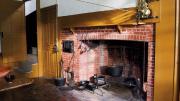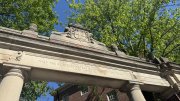I
saac Royall Sr. built a fortune on his Antigua sugar plantation and returned to Boston in 1737 to settle into an opulent Georgian mansion in what’s now Medford, Massachusetts.
To operate the surrounding 500-acre farm, enormous by colonial-era standards, he also shipped north across the ocean “a parcel of negroes.” Those 27 enslaved people were plucked from countless others who labored and lived—and died—for Royall’s lucrative cane fields, according to slavery scholar Kyera Singleton, the new executive director of the Royall House and Slave Quarters museum.
Between 1737 and the death of Royall’s son and heir, Isaac Jr., in 1781, at least 60 men, women, and children were held in bondage on the site. Many were named in Royall family documents, but little is known about most of them beyond that. “We have artifacts, such as game pieces and [clay]pipes,” that reflect “moments of leisure and resistance,” says Singleton, a University of Michigan doctoral candidate and a dissertation fellow in Harvard’s history department. With further research through academic partnerships, the museum hopes to develop a more complete picture of the enslaved people and their experiences. “But what we do know,” Singleton adds, “is that there were enough people there to keep not only the huge farm and its industries going, but to do the daily labor of keeping the household running, and to supplement the Royall family’s lavish lifestyle.”
That fact is the central theme of museum tours. The three-story mansion, decked out as it likely was during the Royall family’s tenure, is a testament to white American wealth enabled primarily by the slave trade. An imposing façade with large windows and wood features crafted to look like stone sets the stage for the plush interior: ornate woodwork; stylish, expensive wallpaper; European-tile fireplace surrounds; and rooms filled with the finest textiles, porcelain, and furniture.
When the site became a museum in 1908, it was restored amid the Colonial Revival movement: the focus was on the Royalls, their Revolutionary-era lives, their fancy furnishings, and their societal contributions. Isaac Royall Jr. served on the Governor’s Council, as town meeting moderator, and as a Harvard Overseer. Money he bequeathed established Harvard’s first law professorship; the family crest stood as the Law School’s official shield until it was retired in 2016 following protests against the brutal origins of the Royall fortune (read the background at harvardmag.com/hls-slavery-17).
Set 35 feet away from the main house are the brick “summer kitchen” and adjoined slave quarters—the only known extant free-standing such structure in northern America. But that history was essentially ignored when the interiors were initially transformed into administrative space and a visitor center. Museum leaders have long since worked to rectify that. They have expanded and integrated interpretations of the site’s history, organized and helped fund an extensive 1999-2001 archaeological excavation, and ultimately plan to restore the quarters. During tours, they also highlight the realities of slaveholding and its economic importance in the North—which still come as a surprise to some visitors.
The quarters consist of the 1737 brick kitchen and the attached two-story clapboard addition built by Isaac Jr. in 1760. The kitchen likely had shared living space above it, and the clapboarded section held ground-floor workshops—a laundry and buttery—along with an open room upstairs where enslaved people slept.
In the main house kitchen, where the site tour begins, Singleton points to the well-worn treads of an unadorned, winding, service staircase—a sharp contrast to the fancy, well-maintained stairs used by the family on the other side of the house. “That’s how we can tell that the enslaved people are going up and down the stairs every single day, multiple times a day,” she says. “It’s a way to think about how they moved through the day, what their work was, and how they are doing everything out of sight.”
To convey other stories about those individuals, the museum relies largely on letters and legal documents, including 1739 room-by-room probate inventories following the death of Isaac Sr. The kitchen list includes five “negroes beds & beding,” along with 18 milk pans. Burlap sacks and pallets are used to represent those who slept there, tending to cooking or warming pans slipped into the Royall family’s beds, Singleton reports. A simple, narrow bed also stands in a chamber above the kitchen, where other enslaved people slept, ready to respond to any overnight needs. “You think of the intimacy of it all,” she says: “The Royalls and the enslaved people lived in very close proximity.”

Enslaved people often slept where they worked. A main house chamber held simple bedding.
Photograph by Theresa Kelliher/Courtesy of the Royall House and Slave Quarters museum
The milk pans reflect the farm’s extensive dairying operations. Museum board member Gracelaw Simmons, who often leads the tours, says there were at least 20 cows, and “it would have been the job of a couple of enslaved women to take the buckets out to find the cows every day, bring back the milk, pour it into the these low, flat pans so the cream rises, scoop the cream into jars, and then the enslaved children—we know as many as 20 percent of the people here were children—would have the job of churning it into butter.” Other glimpses of their lives come from the excavation led by archaeological consultant Alexandra Chan, which unearthed shards of pottery sculpted into what were likely game pieces. These are now on display among other exhibits in the slave quarters’ first-floor room.
The Royalls were not the only slaveholders in the northern colonies, but research by Chan and others suggests they were the largest such household in Massachusetts, by far. Farms in Connecticut and New York needed large numbers of people to grow, harvest, and distribute food—some of it shipped to feed people on Caribbean plantations, Singleton says. The American industrial revolution, birthed in Rhode Island, also depended on cotton produced by slave plantations in the United States. “So, New England is a vital factor in financially supporting and profiting from slavery in the Caribbean and the South—it’s all connected.”

A shared sleeping quarters existed over the separate “summer kitchen.”
Photograph courtesy of the Royall House and Slave Quarters museum
Popular history has tended to focus on Civil War-era and other nineteenth-century slave history, she adds, but it’s important to note that “since the 1700s, free and enslaved black people have been making a life for themselves and challenging Massachusetts on slavery. The Royall House and Slave Quarters is a major part of that narrative through the story of Belinda Sutton.”
Sutton was captured at age 11 in Ghana, and ultimately served the Medford family for decades. When Isaac Jr. died in 1781 in England, having fled the Commonwealth on the cusp of the Revolution, the same will that bequeathed funds to Harvard stipulated that Sutton be given a choice: remain enslaved to his daughter, or become a free woman. She chose freedom. “We know that she either walked to Boston the day after Isaac Royall Jr. fled, or she waited to hear the news that he had died,” Simmons reports, “and that by 1783 [at age 70] she was struggling for resources for herself and her infirm daughter.”
That year she petitioned the Massachusetts House and Senate (as she would five other times within a decade) for pension payments, Singleton says, but only twice received annual allotments of 15 pounds. At least some of her legal documents might have been drafted by the freed slave and black activist Prince Hall; the 1783 document was signed with an X because Sutton was illiterate. But despite rhetoric allying freedom from slavery to the parallel fight for independence from Britain—and the Commonwealth’s relatively pioneering Declaration of Rights—“the legal end of slavery in Massachusetts was messy and slow with no defined date of emancipation,” the exhibit notes reveal.
An excerpt from Sutton’s 1783 petition reads: “Fifty years her faithful hands have been compelled to ignoble servitude for the benefit of an Isaac Royall, until, as if Nations must be agitated, and the world convulsed for the preservation of that freedom which the Almighty Father intended for all the human Race, the present war was Commenced.”
As a historian of slavery, Singleton says, “We cannot talk about issues of mass incarceration, police violence, health, wealth, and educational disparities without thinking about how structural inequality is a legacy of enslavement.” The museum’s role is “to memorialize the lives of the enslaved and to give people the tools to reckon with our current moment,” she continues. “I believe the preservation and amplification of black history, which is American history, is an act of liberation.”












